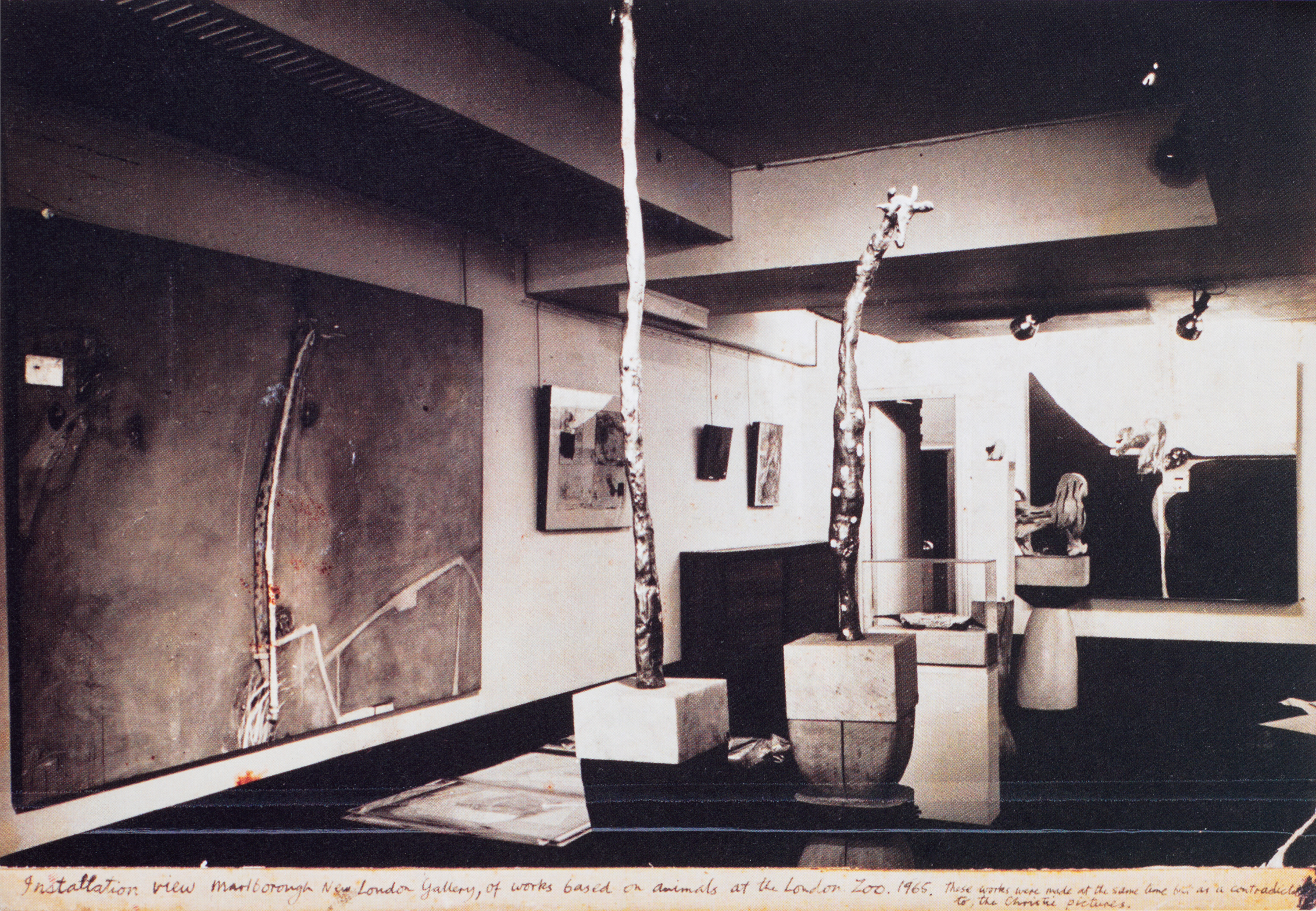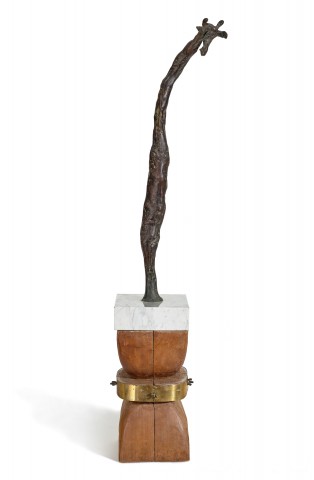GIRAFFE NO. 1, 1964 – 65
BRETT WHITELEY
bronze on marble plinth mounted on carved wood and brass base
189.0 x 45.0 x 31.5 cm (overall, including base)
signed at base of bronze: Brett
Beth Patrick, London, a gift from the artist
Private collection, London, a gift from the above in 2005
Brett Whitele [Zoo series and Christie series], Marlborough New London Gallery, London, 1965, cat. 18
Another Way of Looking at Vincent van Gogh, Art Gallery of New South Wales, Sydney, 4 – 21 August 1983 (another example)
An Exhibition by Brett Whiteley – Eden and Eve, Australian Galleries, Melbourne, 1984, cat. 51 (another example)
162 Drawings: Brett Whiteley: 1960 – 85, Robin Gibson Gallery, Sydney, 1985 (another example)
Brett Whiteley: Art & Life, Art Gallery of New South Wales, Sydney 16 September – 19 November 1995; Museum and Art Gallery of the Northern Territory, Darwin, 13 December 1995 – 28 January 1996; Art Gallery of Western Australia, Perth, 22 February – 8 April 1996; Art Gallery of South Australia, Adelaide, 9 May – 16 June 1996; National Gallery of Victoria, Melbourne, 2 July – 26 August 1996; Tasmanian Museum and Art Gallery, Hobart, 18 September – 17 November 1996, cat. 126 (another example)
A Different Vision: Brett Whiteley Sculptures, The Brett Whiteley Studio, Sydney, 1998 (another example)
Animals and Birds, The Brett Whiteley Studio, Sydney, 2002 (another example)
Key Works from the Studio, The Brett Whiteley Studio, Sydney, 2004 (another example)
Sydney Genesis and Beyond 1955 – 1965, The Brett Whiteley Studio, Sydney, September 2005 (another example)
9 Shades of Whiteley, The Brett Whiteley Studio, Sydney, 2 December 2006 – 9 September 2007 (another example)
Floating World: Landscape, the figure & calligraphy in the art of Brett Whiteley, The Brett Whiteley Studio, Sydney, 21 March – 6 September 2009 (another example)
Iconic Whiteley, The Brett Whiteley Studio, Sydney, 12 September 2009 – 22 August 2010 (another example)
The London Years, 1960 – 67, The Brett Whiteley Studio, Sydney, 13 July 2012 – 13 February 2013 (another example)
Brett Whiteley Sculpture and Ceramics, The Brett Whiteley Studio, Sydney, 5 June – 6 December 2015 (another example)
OTHER PLACES: Somewhere else, The Brett Whiteley Studio, Sydney, December 2015 – May 2016 (another example)
Tributes, The Brett Whiteley Studio, Sydney, 13 May – 13 August 2016 (another example)
Baldessin/Whiteley Parallel Visions, Ian Potter Centre, National Gallery of Victoria, Melbourne, 31 August 2018 – 28 January 2019 (another example)
Lynn, E., The Australian, Sydney, 26 – 27 October 1985 (illus.)
Gray, R., ‘A few takes on Brett Whiteley’, Art and Australia, Sydney, vol. 24, no. 2, 1986, p. 223 (illus.)
Pearce, B., Brett Whiteley: Art & Life, Thames and Hudson in association with the Art Gallery of New South Wales, Sydney, 1995, pl. 45 (illus.), p. 229
Sutherland, K., Brett Whiteley: A Sensual Line, 1957 – 67, Macmillan Art Publishing, Melbourne, 2010, cat. V10, pp. 63, 148, 149 (illus.), 318
Sutherland, K., Brett Whiteley: Catalogue Raisonné: 1955 – 1992, Schwartz Publishing, Melbourne, 2019, cat. 7s, vol. 6, p. 117 (illus. another example), vol. 7, p. 879
The three other examples Giraffe No. 1, 1965 (editions 2, 3 and 4/4) are held in the collection of the Brett Whiteley Estate, Sydney (BWS645, BWS1790 and BWS1791)
Giraffe No. 2, 1965, brass, marble and carved wood, 223.5 x 22.9 x 22.9 cm, private collection, Sydney
We are grateful to Kathie Sutherland for her assistance with this catalogue entry.
Despite being rightly known and celebrated for his paintings and drawings, Brett Whiteley always extended his art beyond the frame, working in three dimensions when both the idea and its realisation demanded it. Across the artist’s oeuvre, forms occasionally explode from the canvas – in the visual and surface chaos of the multi-panelled painting The American Dream, 1968-69, (Art Gallery of Western Australia) for example, with its collaged objects and built-up shapes, and aspects of the natural world, such as branches, birds’ eggs and nests, sometimes represent themselves rather than being depicted by the artist, as if the beauty of their real-life forms defy transcription. Over his relatively short but highly productive career, Whiteley created sculptures from found objects, while also displaying mastery of more traditional techniques such as carving and casting. Indeed, over time, his large-scale sculptures such as Almost Once, 1968/1991 (otherwise known as ‘The Matchsticks’), sited near the Art Gallery of NSW, and Newcastle Art Gallery’s Black Totem II have become instantly recognisable and much-loved public art works.1
Whiteley arrived in London in 1960 after a 10-month stay in Italy following his awarding of the Italian Travelling Scholarship at the Art Gallery of NSW by judge Russell Drysdale in October 1959. He was quickly embraced by the London art scene as a new talent to watch, spearheaded by the inclusion of three of his paintings in Bryan Robertson’s 1961 ‘Recent Australian Painting’ exhibition at the Whitechapel Gallery and the acquisition of his Untitled Red Painting, 1960, from that show, by the Tate Gallery.2
The Whiteleys initially moved into an apartment at Ladbroke Grove in the west London borough of Chelsea and Kensington, a then working-class area filled with British and expatriate Australian artists. Their home was not far from 10 Rillington Place, Notting Hill – the address where renowned serial killer John Christie murdered at least eight women (including his wife) during the 1940s and early 1950s, hiding their bodies in the garden, and in the walls and under the floorboards of his house. Whiteley became obsessed with the macabre story and undertook extensive research for his series on the case. Drawing obvious influence from the powerfully visceral compositions of his mentor, Francis Bacon (who he met in 1961), Whiteley’s Christie works unflinchingly investigate violence, psychosis, and the nature of evil itself; capturing the fear, pain and anguish of Christie’s victims in the contorted, writhing forms of female bodies, distorted to the point of abstraction.
Brett Whiteley, Giraffe

documentary photograph in artist’s ‘orange velvet’ notebook (compiled c.1975)
Art Gallery of New South Wales, Sydney
Whiteley created and exhibited his Regent’s Park Zoo works – comprising paintings, sculptures and the screenprint portfolio, My Relationship between Screenprinting and Regent’s Park Zoo between June and August 1965, 1965 – at the same time as the Christie series, its more prosaic subject matter providing a very real antidote to the intensity of the Christie saga. The idiosyncratic juxtaposition of these two very different bodies of work was a bold move for the young artist, driven entirely by personal need rather than a desire for exhibition coherence. Within the exhibition, the animals provided a positive counterpoint to Christie’s depravity and evil, yet the pent-up energy contained within their physical forms and their appearance, at times, behind the wires of a cage, highlight their role as sentient beings and humankind’s complicity in their ongoing confinement. As Kathie Sutherland has commented: ‘Whiteley’s giraffes, baboons, and apes are alert and express extremes of emotions, seemingly human: melancholy, wariness, anger and curiosity. As a body of work their vitality and awareness of life communicates with the viewer in a way that Christie’s doomed victims, who are silenced, cannot.’3 The Regent’s Park Zoo works also allowed Whiteley to express his extraordinary draughtsmanship and facility of line as he quickly captured the animals in motion.
Giraffe No. 1, 1965 was a key part of the exhibition’s menagerie; its thin, abstracted form embodying, rather than simply depicting the animal’s unusual gait and the slow, swinging motion of the giraffe’s body as it moves. The sculpture clearly shows the influence of Giacometti in its expressive modelling and teetering slender form, as the marks of Whiteley’s fingers impress and shape the giraffe and its exquisitely modelled head; imbuing the animal with a sense of inquisitiveness and charm. Whiteley has seemingly captured the personality of this harmless beast in the graceful curve of its neck and body and the elegant tilt of its head. As time has shown, the artist’s interest in animals was certainly no flash in the pan; Whiteley returned to the animal kingdom as subject throughout his career, with the giraffe appearing in different guises across painting, drawing, prints and sculpture. As Giraffe No. 1 – one of the artist’s first sculptures of this gentle giant, clearly demonstrates, Whiteley’s fascination with animals came from a place of connection, and a lifelong quest for understanding. As he remarked: ’To draw animals, one has to work at white heat because they move so much, and partly because it is sometimes painful to feel what one guesses the animal ’feels’ from inside.4
1. Black Totem II was created by Whiteley and completed by Wendy Whiteley OAM after his death.
2. Whiteley had a second work acquired by the Tate in 1964 –Woman in a Bath II, 1963 from his solo exhibition Brett Whiteley at Marlborough New London Gallery. The Collection now numbers 18 works.
3. Sutherland, K., Brett Whiteley: A Sensual Line, 1957 – 67, Macmillan Art Publishing, Melbourne, 2010, p. 123
4. McGrath, S., Brett Whiteley, Bay Books, Sydney, 1979, p. 62
KELLY GELLATLY
